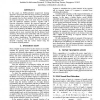Free Online Productivity Tools
i2Speak
i2Symbol
i2OCR
iTex2Img
iWeb2Print
iWeb2Shot
i2Type
iPdf2Split
iPdf2Merge
i2Bopomofo
i2Arabic
i2Style
i2Image
i2PDF
iLatex2Rtf
Sci2ools
ICMCS
2005
IEEE
2005
IEEE
A HMM-Embedded Unsupervised Learning to Musical Event Detection
In this paper, an HMM-embedded unsupervised learning approach is proposed to detect the music events by grouping the similar segments of the music signal. This approach can cluster the segments based on their similarity of the spectral as well as the temporal structures. This is not easily done for clustering with the traditional similarity measures. Together with a Bayesian information criterion, the proposed approach can obtain a suitable event set to regularize the complexity of the model structure. The natural product of the approach is a set of music events modeled by the HMMs. Our experimental analyses show that the detected musical events have more perceptual meaning and are more consistent than the KL-distance based clustering. The learned events match better with our experience in spectrogram reading. Its capacity is further evaluated on a task of music identification. The identification error rate is
| Added | 24 Jun 2010 |
| Updated | 24 Jun 2010 |
| Type | Conference |
| Year | 2005 |
| Where | ICMCS |
| Authors | Sheng Gao, Yongwei Zhu |
Comments (0)

